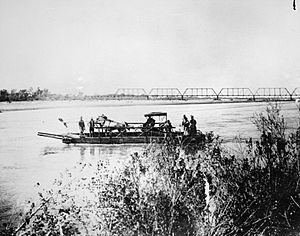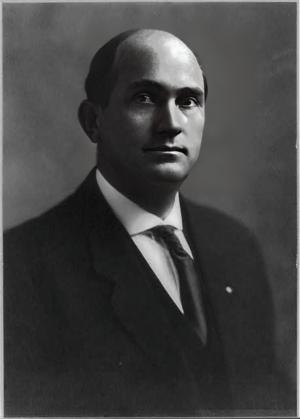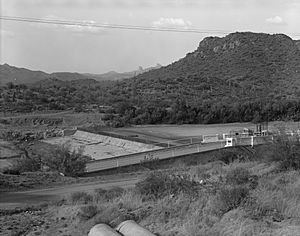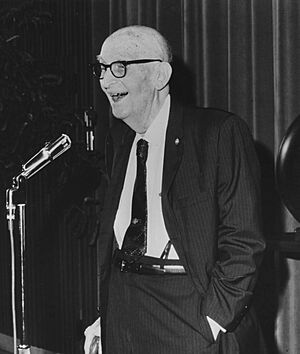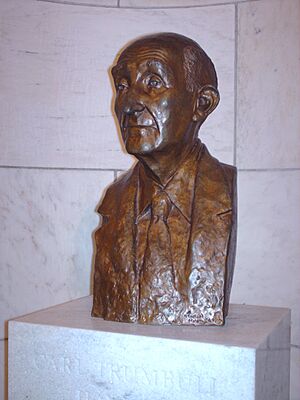Carl Hayden facts for kids
Quick facts for kids
Carl Hayden
|
|
|---|---|
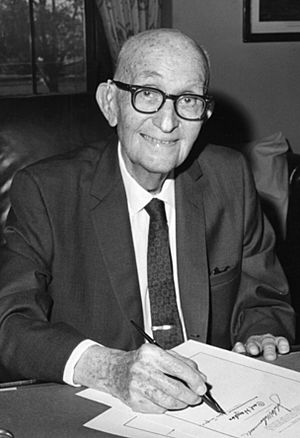
Hayden in 1962
|
|
| President pro tempore of the United States Senate | |
| In office January 3, 1957 – January 3, 1969 |
|
| Preceded by | Walter F. George |
| Succeeded by | Richard Russell Jr. |
| United States Senator from Arizona |
|
| In office March 4, 1927 – January 3, 1969 |
|
| Preceded by | Ralph Henry Cameron |
| Succeeded by | Barry Goldwater |
| Member of the U.S. House of Representatives from Arizona's at-large district |
|
| In office February 19, 1912 – March 4, 1927 |
|
| Preceded by | Ralph Henry Cameron (Territorial delegate) |
| Succeeded by | Lewis W. Douglas |
| 17th Sheriff of Maricopa County | |
| In office 1907–1912 |
|
| Preceded by | William Cunningham (acting) |
| Succeeded by | Jefferson Davis Adams |
| Personal details | |
| Born |
Carl Trumbull Hayden
October 2, 1877 Hayden's Ferry, Arizona Territory, U.S. |
| Died | January 25, 1972 (aged 94) Mesa, Arizona, U.S. |
| Nationality | American |
| Political party | Democratic |
| Spouse | Nan Downing (d. 1961) |
| Alma mater | Arizona State University Stanford University |
| Signature | |
| Military service | |
| Allegiance | |
| Branch/service | United States National Guard |
| Rank | |
| Unit | 9th battalion, 166th Depot Brigade |
| Battles/wars | World War I |
Carl Trumbull Hayden (born October 2, 1877 – died January 25, 1972) was an important American politician. He represented Arizona in the United States Senate from 1927 to 1969. He was the first U.S. Senator to serve seven terms, which is a very long time!
Before becoming a Senator, Hayden served as Arizona's first Representative for eight terms. This made him the longest-serving member of the United States Congress for many years. He was also the Dean of the United States Senate, meaning he was the longest-serving Senator. He led important committees like the Rules and Administration and Appropriations committees. He was a member of the Democratic Party.
Hayden was known for his work on public lands and water projects, especially in the Western United States. He helped create the funding system for the federal highway system. President John F. Kennedy once said that every major program for the West, like irrigation and power, had Hayden's influence.
People called him the "Silent Senator" because he rarely spoke in public. Instead, he worked behind the scenes in committee meetings and private discussions. His ideas were highly respected. A colleague said he had "more influence with less oratory" than anyone else. The Los Angeles Times wrote that other senators were eager to help Hayden's projects for Arizona because he had helped so many of them.
Contents
Early Life and Family
Carl Hayden was born on October 2, 1877, in a place called Hayden's Ferry, Arizona Territory. This town was later renamed Tempe. His father, Charles Hayden, was a merchant from Connecticut. He started a ferry service and other businesses. Carl's mother, Sallie Davis, was a schoolteacher from Arkansas. She also worked to help women get the right to vote in the 1890s.
Carl had three younger sisters. His family ran several businesses, including a ferry, a gristmill (a mill for grinding grain), and a general store. They also had farms.
As a child, Carl traveled quite a bit. He visited Washington, D.C., and the 1893 Chicago World's Fair. He also took solo trips, like riding a horse to the Grand Canyon and visiting Mexico City when he was 14.
Carl went to school in Tempe and then to Arizona Territorial Normal School (now Arizona State University). After graduating in 1896, he went to Stanford University. He studied economics, history, and philosophy. At Stanford, he was a class president and enjoyed debate, writing, football, and track. He met his future wife, Nan Downing, there. They married in 1908 and did not have children.
In 1899, Carl had to leave Stanford early because his father became ill. His father passed away in 1900, leaving Carl in charge of the family and their businesses. Carl sold some businesses to pay debts. He rented out properties to support his mother and sisters, allowing them to attend college. In 1903, he joined the Arizona Territorial National Guard and quickly became a captain.
Starting in Politics
After returning from Stanford, Carl Hayden quickly became involved in the Democratic Party. In 1900, he was a delegate at a county meeting. By 1902, he was chairman of the Maricopa County Democratic Central Committee. He also served on the Tempe town council for two years. He even went to Washington, D.C., to ask for money for the Salt River Project, which was a big water project.
In 1904, Hayden led Arizona Territory's group to the Democratic National Convention. Later that year, he was elected Maricopa County treasurer. This job taught him a lot about public money and budgets. After one term, he decided to run for sheriff, which paid more. In 1906, he won the sheriff election by a large margin.
When Hayden became sheriff, Maricopa County was no longer a "Wild West" area. It was a peaceful farming community. Based in Phoenix, he kept order, collected fees, and transported prisoners. He even used an early car, an Apperson Jack Rabbit, to catch two train robbers! He never had to fire his gun as sheriff.
Serving in the House of Representatives
Carl Hayden first ran for Congress in 1911. This was during a special election before Arizona officially became a state. He was considered an underdog but won the Democratic primary. This win led to his election to the United States House of Representatives.
This election set a pattern for Hayden's future campaigns. He never spoke badly about his opponents. He also traveled around the state with other politicians from his party. He always worked hard for the people he represented. Because he served his constituents well, he rarely faced tough challenges in elections.
Hayden went to Washington, D.C., on the same day President William Howard Taft signed the law making Arizona a state. He was sworn into Congress on February 19, 1912. His main goal was to help Arizona develop its natural resources and build its infrastructure. He wanted the federal government to help because it owned most of the land in Arizona.
During his first full term, Hayden supported President Woodrow Wilson's policies. He helped pass laws like the Clayton Anti-Trust Act and the Federal Reserve Act. He also supported the creation of the Federal Trade Commission. He introduced a resolution for women's suffrage (the right for women to vote), honoring his mother.
Hayden worked to extend repayment times for loans used in water projects. He also helped pass a law in 1922 that allowed money from selling hydroelectric power to help pay off project debts. He believed local groups should control water projects. In 1917, he wrote a law that gave control of the Salt River Project from the federal government to a local group. This became a model for other water projects in the West. He also helped create the Grand Canyon National Park.
Hayden worked for a major water project on the Gila River. He helped get money for a study and then introduced a bill for the San Carlos Project in 1914. Even though it was first defeated, he found a way to get parts of it funded. By 1922, a dam was completed and named the Ashurst-Hayden Dam, after him and another Arizona Senator. The main dam for the project, the Coolidge Dam, was approved in 1924.
Hayden supported the American entry into World War I. He helped make sure that people drafted into the military couldn't pay to avoid service. He also believed in treating conscientious objectors (people who refuse to fight for moral reasons) humanely. Before the war, he was a Major in the Arizona Army National Guard. He volunteered to serve and helped prepare his unit for duty.
While in the House, Hayden became involved in a long argument over water rights for the Colorado River. California wanted to build a dam and a canal without sending water through Mexico. Arizona disagreed with how the water would be shared. Hayden became a leader against the Boulder Canyon Project bill, using special parliamentary procedures to stop it from being voted on until he left the House.
Moving to the Senate
In 1926, Carl Hayden ran for the United States Senate. His campaign focused on how he protected Arizona's water rights against California. He even used newspaper headlines from California that criticized him for stopping the Boulder Dam bill. He won the election, becoming a U.S. Senator.
When he joined the Senate in March 1927, Hayden got important committee jobs, including a seat on the Appropriations Committee. This committee controls how government money is spent. This meant much of his work shifted to managing funds for projects. He also served on committees dealing with Interior and Insular Affairs (public lands), Post Office and Post Roads, and Rules and Administration.
The 1920s: Water Battles Continue
Hayden continued to oppose the Boulder Canyon Project in the Senate. But it became clear that the project would eventually pass. He worked to get better terms for Arizona. With help from Arizona's other Senator, Henry F. Ashurst, Hayden used filibusters (long speeches to delay a vote) to slow down the bill. In May 1928, Hayden gave his first speech in the Senate, talking for nine hours!
The Boulder Canyon Project finally passed in December 1928. Even though Hayden opposed it, the final bill included some important wins for Arizona. Arizona got exclusive rights to water from the Gila River. The bill also included money for Arizona and Nevada. After the bill passed, Hayden changed his strategy and tried to stop funding for the project instead.
The 1930s: Building America
In 1932, Hayden almost lost his election. People were unhappy about his votes on some issues during the Great Depression. But he managed to win.
When President Franklin D. Roosevelt started the New Deal in 1932, Hayden stopped opposing the Boulder Canyon Project. Instead, he started pushing for more irrigation and hydroelectric projects. He strongly supported the Central Valley Project and helped get money for the Grand Coulee Dam. Senator Warren Magnuson later called him "the father of the Grand Coulee Dam."
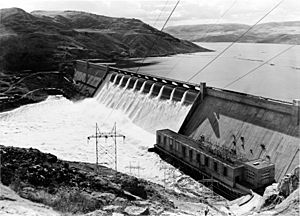
Hayden was very interested in building highways. He was on the Senate Committee on Post Office and Post Roads. President Roosevelt once asked him why he always wanted to talk about roads. Hayden replied, "Because Arizona has two things people will drive thousands of miles to see—Grand Canyon and the Petrified Forest. They can't get there without roads."
In 1933, he helped get $400 million for highway construction. The next year, he and Representative Wilburn Cartwright introduced the Hayden-Cartwright Act. This law was important because it allowed money for planning future roads and for roads in cities, not just rural areas. It also stopped states from using highway money for other things. A later Hayden-Cartwright Act allowed federal money for roads on Indian reservations and in national parks and forests. Hayden also cared about highway safety. He worked with Senator Harry S. Truman to propose cutting federal funds for states that didn't have licensing requirements.
The 1940s: War and Water
When World War II started in the 1940s, Hayden focused on war needs. He helped create many military bases in Arizona, like Luke and Williams, because of the good flying weather. He also helped set up an Army Desert Training Center for troops preparing for the North African campaign.
In 1945, Hayden faced a personal sadness when his wife, Nan, had a stroke. She needed constant care until she passed away in 1961.

After a 1944 treaty with Mexico about Colorado River water, Hayden began working to bring water from the river to Phoenix and Tucson. He and Senator Ernest McFarland introduced a bill in 1946 to build the Central Arizona Project. They tried again in 1947, and it passed the Senate but was stopped in the House by California.
The 1940s also saw Hayden become a key committee chairman. He often served as acting chairman of the Appropriations Committee. This helped him gain a reputation for working effectively behind the scenes. He also became chairman of the Senate Rules Committee.
The 1950s: More Records and Challenges
Hayden continued his efforts for the Central Arizona Project in the 1950s. The bill was defeated again in 1951. This led Arizona to take the water rights issue to the U.S. Supreme Court. The case, Arizona v. California, took over ten years to decide. Hayden also helped pass the Colorado River Storage Act of 1956, which allowed building the Glen Canyon Dam and other dams.
Arizona's politics started to change in the 1950s. Many new people moved to the state, and the Republican Party grew stronger. While long-time residents knew Hayden well, many new voters didn't. So, his 1956 campaign used TV and radio to remind voters of his achievements.
In 1956, Hayden was involved in a legal argument when a judge tried to stop the Senate from publishing a document. Hayden, as chairman of the Joint Committee on Printing, said the order was against the Constitution. He ordered the Government Printing Office to ignore the court order. Another judge later agreed that the court had no right to interfere with Congress.
In 1955, Hayden became chairman of the Senate Appropriations Committee. He also set new records for how long he had served in Congress. He broke the record for continuous service in 1957 and for total length of service in 1958. His record for longest service was not broken until 2009 by Robert Byrd.
The 1960s: Final Victories
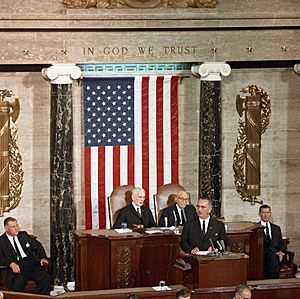
In 1962, Hayden was in the news because of a disagreement between the Senate and House Appropriations Committees. The dispute was about where their meetings to discuss money bills would take place. Hayden found a meeting room halfway between the two chambers. The issue was finally resolved in July when a huge amount of money for government programs was at risk.
During his last campaign in 1962, the Central Arizona Project was the main topic. Arizona leaders felt Hayden's long experience was vital to get the project approved. His campaign celebrated his 50th anniversary in Congress. Despite rumors about his health, Hayden won a record seventh term. It was his closest election ever, but he still won by a good margin.
Hayden twice moved up to second place in the presidential line of succession. This meant he would become president if both the President and Vice President were unable to serve. The first time was in 1961, and the second was after President John F. Kennedy was assassinated in 1963. When asked what he would do if he became president, Hayden joked that he would call Congress, have them elect a new Speaker, and then resign.
Hayden's biggest legislative success was the approval of the Central Arizona Project. On June 4, 1963, after the Supreme Court ruled in Arizona's favor, Hayden and other Arizona politicians reintroduced the bill. Hayden's influence helped it pass the Senate. It was harder in the House, but Hayden used a clever move by adding his bill to a larger bill that many Congressmen wanted. This forced a hearing on the Central Arizona Project.
The Central Arizona Project was finally approved on September 30, 1968. President Johnson declared that day "Carl Hayden Day." Hayden said it was "the most significant accomplishment of my career."
How He Worked
Carl Hayden kept a very low profile for someone who spent over 50 years in Washington. Early in his career, he was told there are "show horses" (who seek attention) and "work horses" (who get things done quietly). Hayden chose to be a "work horse."
He quickly became known as a "service congressman" because he always responded to letters from the people he represented. He believed politics should end after an election, and he helped everyone, no matter their party.
Hayden avoided public speaking. After his long speech about Boulder Dam, he didn't give another speech in the Senate for 20 years! Many of his colleagues had never heard him give a full speech. But this didn't stop him from being effective. Senator Lyndon B. Johnson said Hayden proved that "effectiveness and statesmanship are not necessarily coupled with talkativeness."
After His Time in Office
Carl Hayden announced his retirement on May 6, 1968. He said that after 56 years, it was time for "new building crew" to take over. He suggested his aide, Roy Elson, to replace him, but Elson lost to former Senator Barry Goldwater.
After retiring, Hayden returned to Tempe. He set up an office at Arizona State University's library. He organized his papers and worked on a biography of his father. He became ill in January 1972 and passed away on January 25, 1972. He was buried in Tempe's Double Butte Cemetery. Speakers at his memorial service included Barry Goldwater and former President Lyndon B. Johnson.
Many things have been named after Carl Hayden because of his long service. In 1957, Phoenix Union High School District named Carl Hayden High School after him. In 1969, the visitor center overlooking Glen Canyon Dam was named in his honor. Even after his death, the U.S. Department of Agriculture's Carl Hayden Bee Research Center was named in 1978. The U.S. Department of Veterans Affairs' Carl T. Hayden VA Medical Center was named in 1987. A statue of Hayden was placed in the Russell Senate Office Building in 1986.
Images for kids
-
Hayden was called "the father of the Grand Coulee Dam."
-
The Central Arizona Project, called "the most significant accomplishment of my career" by Hayden.
-
Hayden (center) with House Speaker John W. McCormack (left) during a 1963 address by President Lyndon B. Johnson (right)
See also
 In Spanish: Carl Hayden para niños
In Spanish: Carl Hayden para niños


